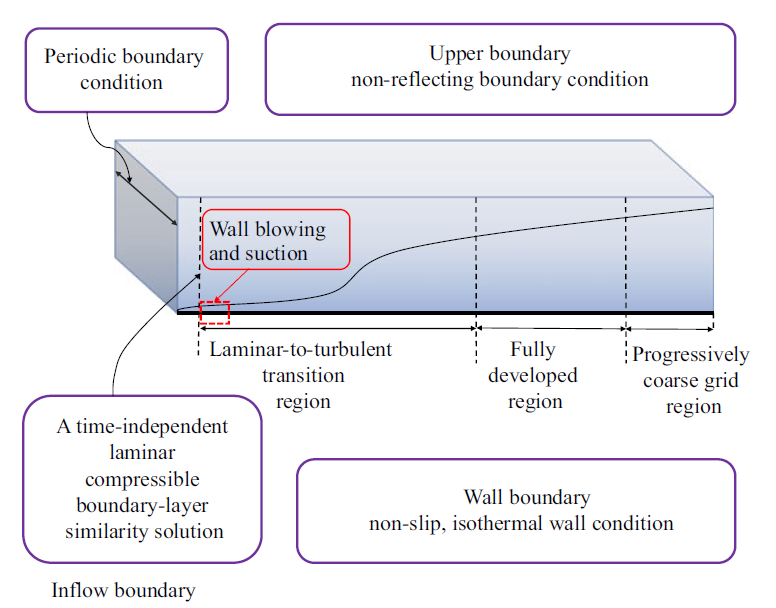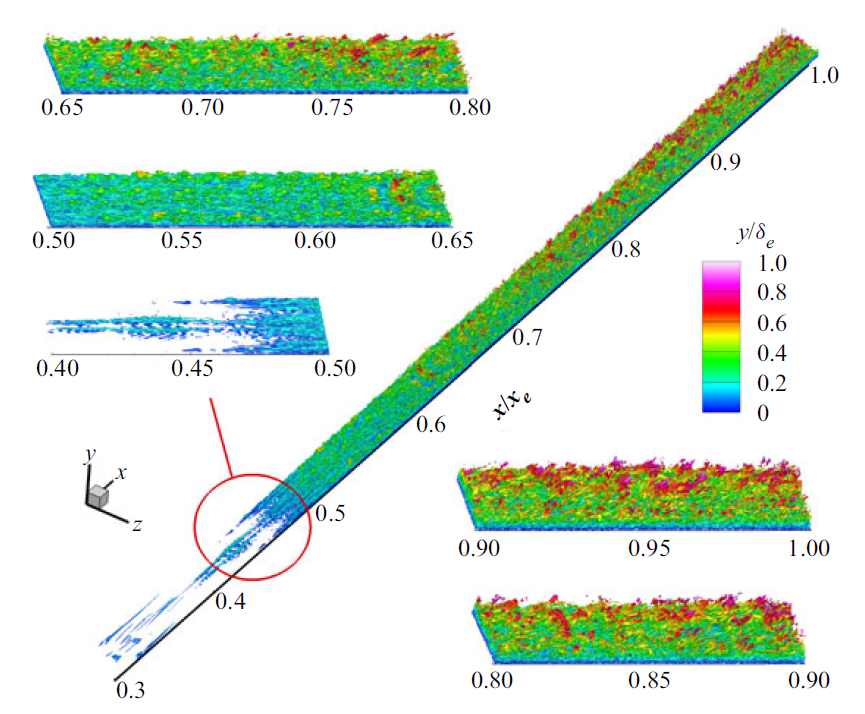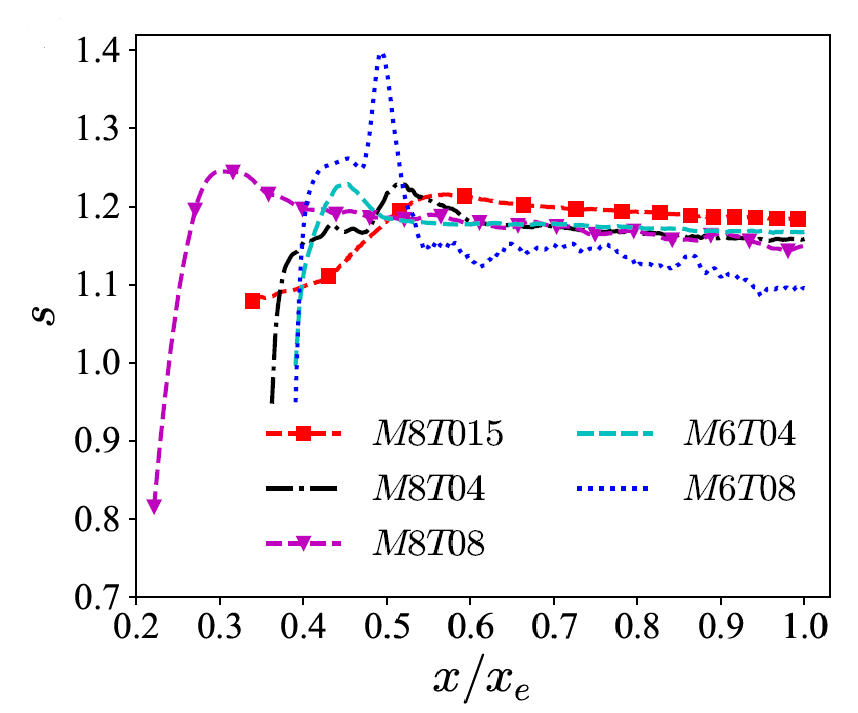When fluid passes through the surface of the hypersonic vehicles, the laminar flow at the inlet is gradually transitioned to the turbulent state along the flow direction. In the complex laminar-to-turbulent transition process, it is often found that the wall skin friction and heat transfer at the transition peak is greater than those in the fully developed turbulent state. This phenomenon is named “the overshoot phenomenon”.
However, there is a lack of systematic investigation of the underlying mechanism of the overshoot phenomenon. Therefore, it is extremely difficult to accurately predict the wall skin friction and heat transfer at the transition peak, which also poses a great challenge to the design of efficient drag reduction and heat protection methods. All in all, exploring the main reasons for the overshoot phenomenon is an important subject to be studied urgently.

Associate Professor Jianchun Wang’s team from the Department of Mechanics and Aerospace Engineering at the Southern University of Science and Technology (SUSTech) has recently made significant progress in the research of the decompositions of the wall skin friction and heat transfer in hypersonic transitional and turbulent boundary layers.
Their relevant research, entitled “Skin-friction and heat-transfer decompositions in hypersonic transitional and turbulent boundary layers,” has been published in the Journal of Fluid Mechanics, a leading international journal concerned with developments in fluid mechanics.
In this study, the main reasons for the overshoot phenomena of the wall skin friction and heat transfer in hypersonic transitional and turbulent boundary layers were revealed for the first time by using the von Karman boundary layer quadratic integration method. It provides theoretical guidance for the design of efficient methods of thermal protection and drag reduction in hypersonic vehicles.
In wall-bounded flows such as channels and boundary layers, when the flow undergoes the laminar to turbulent transition, the interesting phenomena found that the mean skin friction and heat transfer at the transition peak are larger than those in the fully developed state. This is named the overshoot phenomena of the wall skin friction and heat transfer.
Although the overshoot phenomena were widely found in the wall-bounded flows, including the channels and boundary layers, there is no reasonable explanation for the underlying flow mechanism. It was found in previous studies that the Reynolds shear stress and Reynolds heat flux have maximum values at the transition peak. Therefore, speculation was given that the Reynolds shear stress and Reynolds heat flux are the main reasons for the overshoot phenomena of the wall skin friction and heat transfer.
However, according to Prof. Wang’s team, the maximum values of the Reynolds shear stress and Reynolds heat flux at the transition peak does not mean that the Reynolds shear stress and Reynolds heat flux can make major contributions to the overshoot phenomena of the wall skin friction and heat transfer. Accordingly, the von Karman boundary layer quadratic integration method was introduced. It decomposed the mean wall skin friction and heat transfer coefficients into the sum of the integrals of the different statistics along the wall-normal direction among the boundary layer. A large positive value of the integral of the flow statistics represents the main contribution to the mean wall skin friction and heat transfer coefficients. This method is utilized to explore the underlying mechanism of the overshoot phenomena of the wall skin friction and heat transfer.

Figure 1. The computational schematic of the hypersonic transitional and turbulent boundary layers
The direct numerical simulations of the hypersonic transitional and turbulent boundary layers are performed by the high-precision finite difference method, and the computational schematic is shown in Figure 1. Initially, the time-independent laminar compressible boundary-layer similarity solution is applied at the inflow boundary. A region of the wall blowing and suction is implemented to induce the laminar-to-turbulent transition.
In Figure 2, it reveals the visualization of the instantaneous vortical structures based on the Q-criterion. At the onset of the flat plate, the laminar flow is disturbed by the wall blowing and suction, resulting in the streamwise vorticity near the wall. Furthermore, as the streamwise location increases, the laminar flow is transitioned to the turbulent flow, and complicated vortical structures appear.

Figure 2. Visualization of the instantaneous vortical structures based on the Q-criterion

Figure 3. The Reynolds analogy factor along the streamwise direction
The Reynolds analogy factor along the streamwise direction of the five DNS databases at Mach numbers 6 and 8 with different wall temperatures. It found that similar to the behaviors of the mean wall skin friction and heat transfer, an overshoot phenomenon is also found in the evolution of the Reynolds analogy factor. Furthermore, the Reynolds analogy factor slightly increases as the wall temperature decreases.

Figure 4. Streamwise evolutions of the relative contributions of the components to the mean wall skin friction coefficient
Streamwise evolutions of the relative contributions of the components to the mean wall skin friction coefficient is shown in Figure 4. Here (CMf + CD,1f )/Cf represents the relative contributions of the mean velocity gradients to the mean wall skin friction coefficient, and CTf /Cf represents the relative contributions of the Reynolds shear stress. The light red vertical dotted line represents the streamwise location of the transition peak.
It found that the value of (CMf + CD,1f )/Cf is much larger than that of CTf /Cf at the transition peak, indicating that the overshoot phenomenon of the mean wall skin friction is mainly due to the drastic variation of the mean velocity gradients. Therefore, the speculation given in the previous studies that the Reynolds shear stress is the main reason for the overshoot phenomenon of the mean wall skin friction is not appropriate.

Figure 5. Streamwise evolutions of the relative contributions of the components to the mean wall heat transfer coefficient
Streamwise evolutions of the relative contributions of the components to the mean wall heat transfer coefficient are shown in Figure 5. Here (CMh + CD,1h)/Ch represents the relative contributions of the viscous dissipation to the mean wall heat transfer coefficient, and CTh /Ch represents the relative contributions of the Reynolds heat flux. The term (CMh + CD,1h)/Ch is the sole positive term, indicating that the viscous dissipation gives the main contribution to the overshoot phenomenon of the mean wall heat transfer. Therefore, the speculation given in the previous studies that the Reynolds heat flux is the main reason for the overshoot phenomenon of the mean wall heat transfer is not appropriate.
Dehao Xu, a Ph.D. student at Peking University and visiting student in Assoc. Prof. Jianchun Wang’s research group, is the first author of the paper. Assoc. Prof. Jianchun Wang and Prof. Shiyi Chen are the co-corresponding authors. SUSTech is the correspondence institute.
This work was supported by the Basic Science Center Program of the National Natural Science Foundation of China (NSFC), Technology and Innovation Commission of Shenzhen Municipality, and the Department of Science and Technology of Guangdong Province.
Paper link: https://doi:10.1017/jfm.2022.269
To read all stories about SUSTech science, subscribe to the monthly SUSTech Newsletter.
Proofread ByAdrian Cremin, Yingying XIA
Photo By